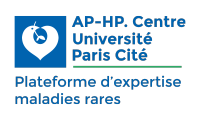The translational medicine and targeted therapies research team, led by Pr Guillaume Canaud at the Institut Necker-Enfants malades (Université Paris Cité, AP-HP, Inserm), in collaboration with the team from the maxillofacial surgery department of the Necker-Enfants malades AP-HP hospital (Prof. Roman Khonsari and Prof. Arnaud Picard) and the « shape and growth of the skull » laboratory (Pr Roman Khonsari) has studied the PIK3CA pathway in patients suffering from a rare disease affecting the muscles of the face, hemifacial myohyperplasia.
The results of this study were published on 15 September 2023 in the Journal of Experimental Medicine.
Hemifacial myohyperplasia (HFMH) is a rare cause of asymmetry involving exclusively the facial muscles. This disorder is reported in very few patients in the literature. The genetic causes and mechanisms of progression of HFMH have hitherto been unknown.
To date, its management has been punctuated by diagnostic errors and inadequate strategies, including aggressive attempts at surgical correction (muscle remodelling surgery). The results were always disappointing, with significant sequelae.
The recent discovery of the role played by somatic mutation of genes activating the PIK3CA/AKT/mTOR pathway has opened up new therapeutic prospects for patients.
In particular, gain-of-function PIK3CA mutations explain the vast majority of proliferation syndromes.
Canaud and Khonsari research teams and clinicians hypothesised that the PIK3CA/AKT/mTOR pathway was abnormally affected in patients with HFMH.
Five patients with HFMH were included in this study.
A gain-of-function mutation in the PIK3CA gene was found in the facial muscles of these five patients. It resulted in striated muscle cell hypertrophy, mitochondrial dysfunction and hypoglycaemia with low circulating insulin levels.
To understand the pathophysiology of muscle hypertrophy, Prof Canaud’s research team created a mouse model specifically carrying a PIK3CA mutation in skeletal muscle.
Treatment with alpelisib, an approved PIK3CA inhibitor, was able to prevent and reduce muscle hypertrophy in the mouse model with correction of the endocrine abnormalities.
Pr Canaud’s team obtained authorisation to treat the five patients with alpelisib and observed a clear improvement in muscle hypertrophy in all patients, associated with progressive symmetrisation of the face. Response to treatment was assessed and confirmed using innovative imaging methods, including 3D photography and analysis of 2D photographs using artificial intelligence. These morphological approaches were confirmed by cellular and molecular methods which demonstrated that alpelisib had a positive and prolonged action on the effects of the PIK3CA gene mutation.
These results mean that we finally have a genetic explanation for patients with haemifacial myohyperplasia, an understanding of the mechanisms of the disease and the prospect of an effective therapeutic approach.
Source : AP-HP


